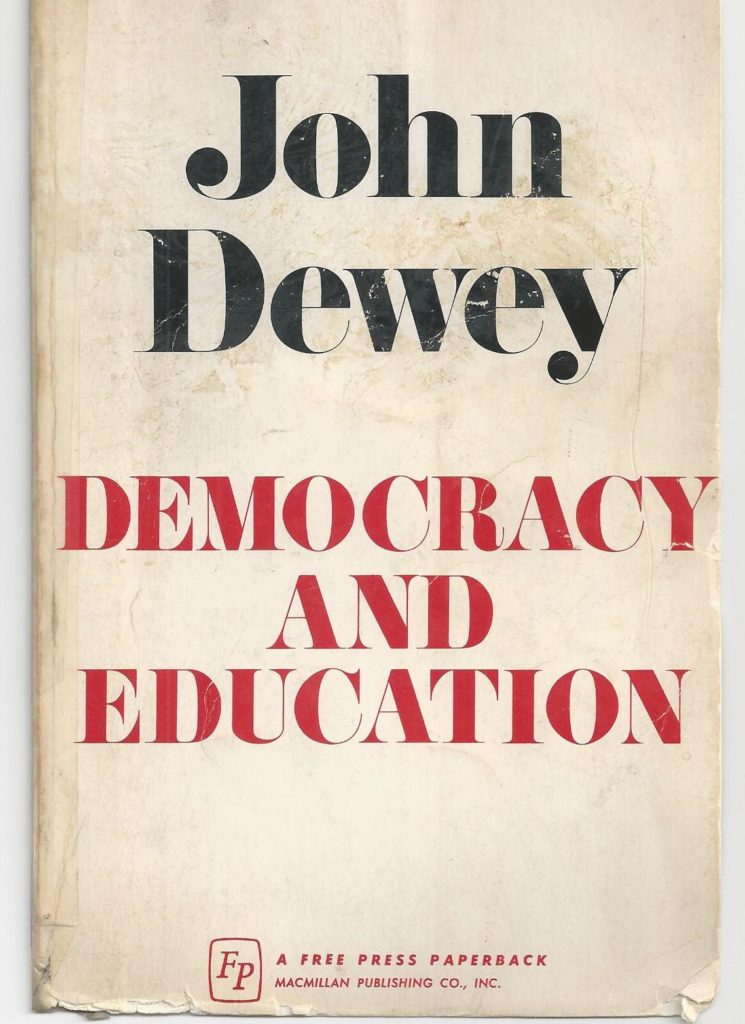
Whether or not the term “learning by doing” originated with John Dewey is somewhat irrelevant to the fact that it is often associated with the kind of schooling he articulated and, with the help of others, implemented at what became known as the Laboratory School at the University of Chicago between 1895 and 1904. During that decade, he both lectured and wrote about what this meant; School and Society and “The School as Social Center” are representative.
For a year or so before he left the university, Dewey also had oversight responsibility for the Chicago Manual Training School, which had been established in the 1880s by the city’s Commercial Club. It was headed by Henry H. Belfield, who had previously been a principal of several Chicago high schools and thus was a colleague of Ella Flagg Young, who later worked with Dewey at the University of Chicago. Connections among these three – Belfield, Young, and Dewey – are the subject of ongoing research. (See the web page on Ella Flagg Young for more information.) Though initial interest in manual training programs – in the 1880s – had conceived of them rather idealistically as an outgrowth of the arts and crafts movement, by 1910 or so, they were increasingly viewed as a means of providing a compliant work force for the nation’s growing industries. To this, Dewey (and Young) strongly objected. Over the next decade, Dewey wrote often about what he called the right kind of industrial education – schooling that would prepare students for an active and productive life as citizens in a democracy.
In recent years, Dewey has been criticized for misinterpreting the educational priorities of black communities, particularly as they were described in the 1915 book Schools of Tomorrow, which he wrote with his daughter Evelyn Dewey. It is of no little interest that the principal of the school the Deweys described in that book, P.S. 26 in Indianapolis, would go on to head for 35 years the Manual Training and Industrial School in Bordentown, NJ. The latter institution arguably implemented many of Dewey’s principles for the right kind of industrial education. Though labeled a “Tuskegee,” the school and its principal apparently won the approval of W.E.B. Du Bois. (Bordentown’s MTIS lists readings that set the school in the context of controversy about whether industrial education was appropriate for African-American students.)
John Dewey on Industrial Education
Listed below are Dewey’s major works on the topic of manual training or industrial education, plus some articles – critical and otherwise – commenting on them. (The references to Middle Works are to the Collected Works of John Dewey, edited by Jo Ann Boydston, and published over several years by Southern Illinois University Press.)
- “The Place of Manual Training in the Elementary Course of Study,” Manual Training Magazine 2 (1901); also Middle Works 1:230.
- The School and Society, available in numerous editions; originally a series of talks delivered in 1899 to parents of the Laboratory School and published by one of its supporters; also in Middle Works 1: 1-109.
- “The School as Social Center,” Elementary School Teacher 3 (1902): 73-86; also in Middle Works 2: 80-95. (Originally a 1902 address to the National Council on Education.)
- “Some Dangers in the Present Movement for Industrial Education,” in Middle Works 7: 98-103 (originally published as “An Undemocratic Proposal” in American Teacher 2 (1913): 2-4).
- “A Policy of Industrial Education,” New Republic, December 19, 1914, 11-12; also in Middle Works 8: 97.
- “Splitting Up the School System,” New Republic 2 (1915): 283-84; also Middle Works 8: 123-127.
- “Industrial Education – A Wrong Kind,” New Republic 2 (1915): 71-73; also Middle Works 8: 117-122. This was followed by “Two Communications” by Dewey and David Snedden, New
- Republic 3 (May 15, 1915): 40-44; also“Education vs. Trade Training” and “Vocational Education” in Middle Works 8.
- The School as a Social Settlement,” Schools of Tomorrow (with Evelyn Dewey), available in several editions, including a reprint by Grindl Press (grindlpress.com); also Middle Works 8: 205-404. (This chapter describes the Indianapolis school headed by William Valentine, who in 1915 became principal of the Manual Training School in Bordentown; the book also includes a chapter called “Education Through Industry,” which is about similar programs in other cities, schools that served largely white immigrant communities.)
- “Vocational Aspects of Education,” chap. 23 in Democracy and Education; available in numerous editions; originally published in 1916 by Macmillan, New York.
- “The Need of an Industrial Education in an Industrial Democracy,” Manual Training and Vocational Education17 (1916); also Middle Works 10: 137-143.
- “Learning to Earn: The Place of Vocational Education in a Comprehensive System of Public Education,” School and Society 5, 117 (March 24, 1917): 331-335; also Middle Works 10: 144-150.
Commentaries about Dewey’s Approach
- Anthony DeFalco, “An Analysis of John Dewey’s Notion of Occupations: Still Pedagogically Valuable?” Education and Culture 26, 1(2010): 82-99; and “Dewey and Vocational Education: Still Timely?” The Journal of School and Society 3, 1 (2016): 54-64. (Note that this entire issue is dedicated to contemporary vocational education programs.)
- Thomas Fallace, Dewey and the Dilemma of Race: An Intellectual History, 1895-1992. New York: Teachers College Press, 2011.
- Joseph F. Kett, “’Theory Run Mad’: John Dewey and ‘Real’ Vocational Education,” Journal of the Gilded Age and Progressive Era 16 (2017): 500-514.
- Frank Margonis, “John Dewey’s Racialized Visions of the Student and Classroom Community,” Educational Theory 59, 1 (2009): 17-39.
- Kelly Vaughan. “Progressive Education and Racial Justice: Examining the Work of John Dewey.” Education and Culture 34, 2 2018): 39-68.